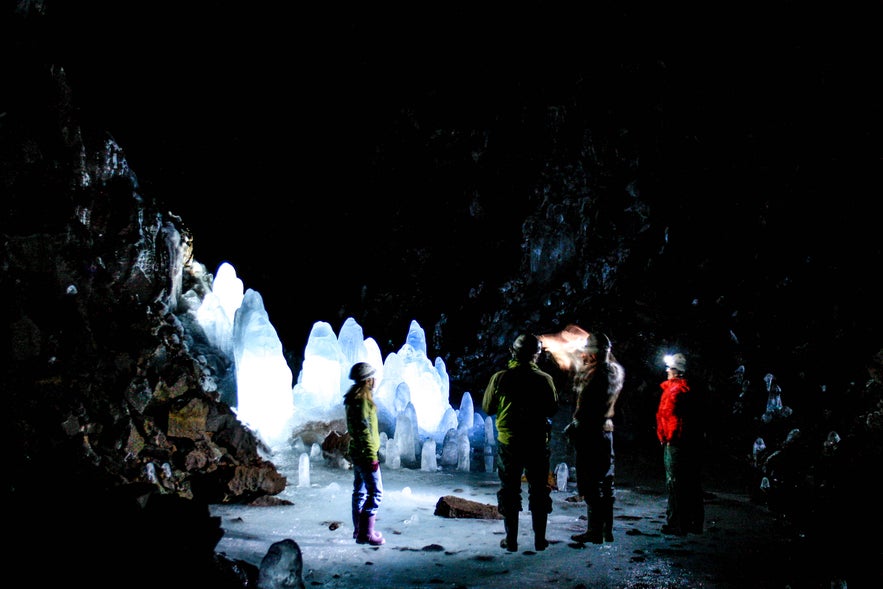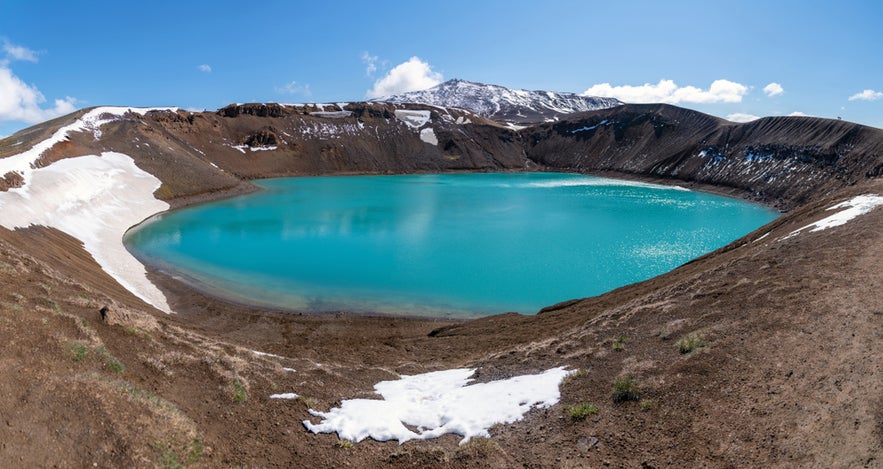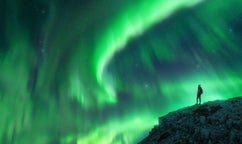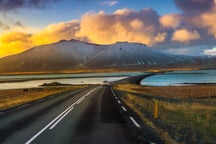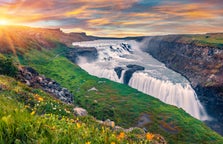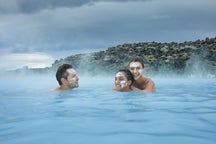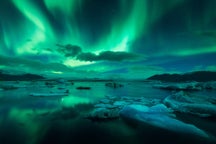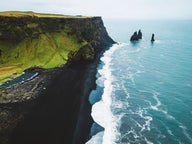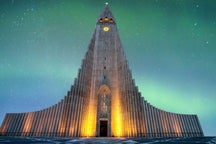
Discover the top things to do in Myvatn, the famous lake area surrounded by hot springs, lava fields, volcanic craters, and rich birdlife. Read on to plan your trip to one of North Iceland's most stunning destinations.
When out on Lake Myvatn explorations, you'll see landscapes shaped by a massive volcanic eruption thousands of years ago, filled with striking geological formations. Pseudocraters, lava pillars, and bubbling geothermal pools reveal the powerful forces that continue to shape Iceland’s terrain.
Why You Can Trust Our Content
Guide to Iceland is the most trusted travel platform in Iceland, helping millions of visitors each year. All our content is written and reviewed by local experts who are deeply familiar with Iceland. You can count on us for accurate, up-to-date, and trustworthy travel advice.
Lake Myvatn is also one of the main highlights of the Diamond Circle, a popular travel route in North Iceland. Guided Diamond Circle tours and relaxing hot spring tours give you plenty of ways to experience the area’s natural beauty.
For an easy day trip, you can join a Lake Myvatn sightseeing and hot springs tour from Akureyri and visit the region’s highlights with a knowledgeable guide. Continue reading to explore more travel tips, top attractions, and the best ways to plan your visit.
Key Takeaways
-
Lake Myvatn is one of North Iceland’s top destinations, shaped by volcanic eruptions and famous for its lava fields, pseudocraters, geothermal pools, and birdlife.
-
It’s a highlight of the Diamond Circle Sightseeing Route, close to Dettifoss Waterfall, Asbyrgi Canyon, Godafoss Waterfall, and the town of Husavik.
-
Top attractions include Dimmuborgir Lava Formations, Hverfell Crater, Namaskard Geothermal Area, Grjotagja Cave, Viti Crater, Lofthellir Ice Cave, Skutustadagigar Pseudocraters, and the Earth Lagoon (Myvatn Nature Baths).
-
The best time to visit depends on the season: summer brings the midnight sun, hiking, and birdwatching, while winter offers northern lights, dog sledding, and snowy scenery.
-
Accommodation and dining options range from modern hotels like Fosshotel Myvatn to cozy farm stays like Vogafjos, with local favorites such as Daddi’s Pizza.
-
Lake Myvatn is about a 6–7 hour drive from Reykjavik, or 1.5 hours from Akureyri by car. Visitors can also take domestic flights or join guided tours.
How Lake Myvatn Was Formed
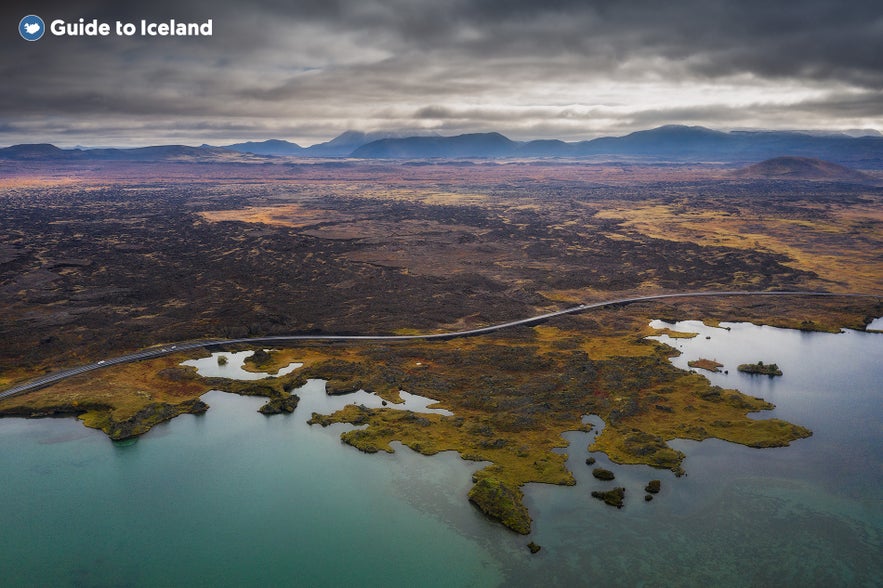
Lake Myvatn in Iceland was formed about 2,300 years ago after a large basaltic lava eruption. As the lava spread across the region, it reached wetlands and other low-lying areas.
When the hot lava touched the water, it caused strong steam explosions. These blasts created pseudocraters, which are small, crater-shaped formations made by steam rather than by real volcanic eruptions.
The same lava flow also blocked the natural drainage in the region. This trapped the water and eventually formed Lake Myvatn.
Today, it is one of the largest lakes in Iceland, covering about 14 square miles (37 square kilometers). The lake is shallow, with an average depth of about 8 feet (2.5 meters).
Nature and Wildlife of Lake Myvatn
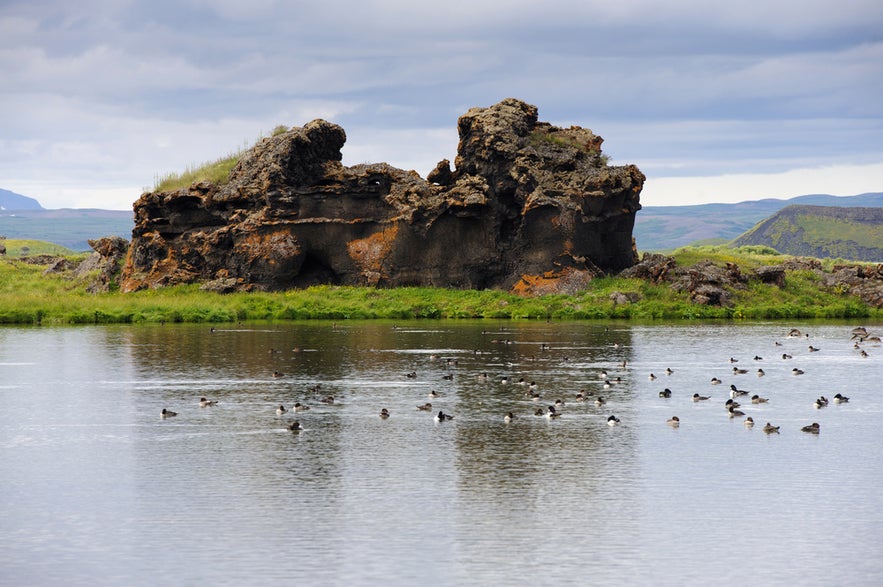 Lake Myvatn is known for its rich plant and animal life because the lake is shallow and full of nutrients. Its diverse environment makes it one of the most fascinating natural spots in North Iceland.
Lake Myvatn is known for its rich plant and animal life because the lake is shallow and full of nutrients. Its diverse environment makes it one of the most fascinating natural spots in North Iceland.
The name "Myvatn" means "Midges Lake," referring to the tiny, mosquito-like insects that gather around the water. These swarms are one of the first things visitors notice in summer and play an important role in the lake’s ecosystem.
The midges provide a key food source for many birds in Iceland. Their abundance, along with other aquatic insects, supports several duck species throughout the year.
Birdlife
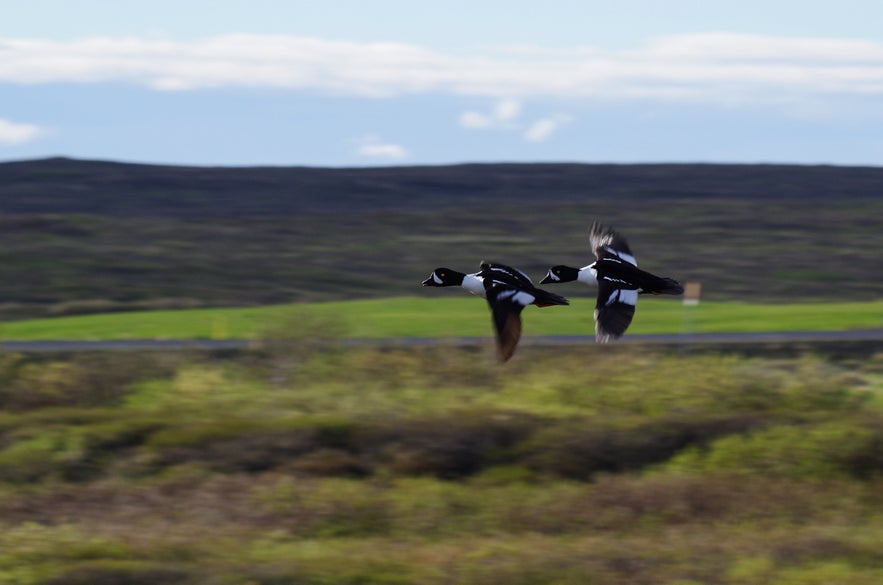 This area is home to many kinds of birds and is a popular spot for birdwatching in Iceland. You might see whooper swans, Arctic terns, red-necked phalaropes, great northern divers, and Eurasian wigeon around the lake, along with many species of ducks.
This area is home to many kinds of birds and is a popular spot for birdwatching in Iceland. You might see whooper swans, Arctic terns, red-necked phalaropes, great northern divers, and Eurasian wigeon around the lake, along with many species of ducks.
Most of the ducks here are migratory, arriving in spring via northwestern Europe. Common species include the tufted duck and greater scaup, and you may also see Barrow’s goldeneye, northern shoveler, and mallard.
Marimo Moss Balls
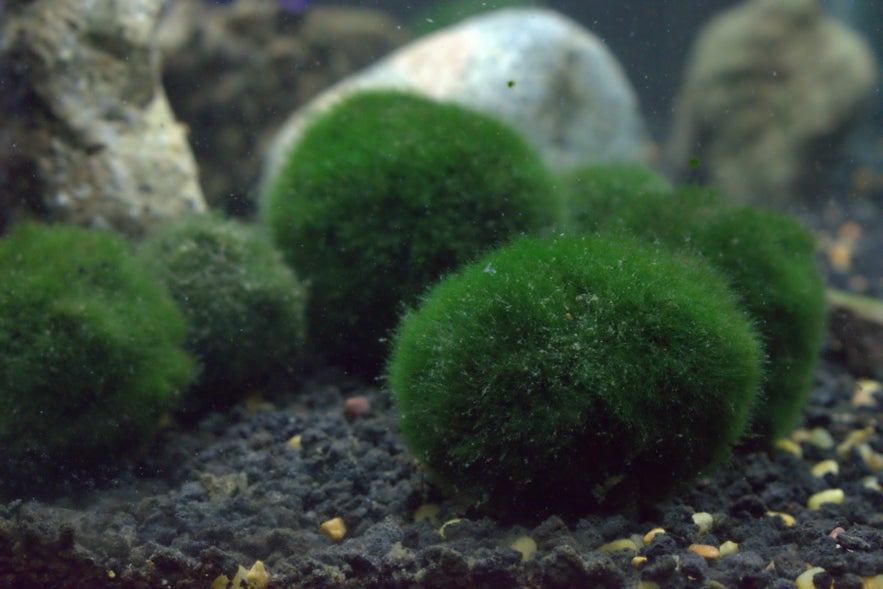 Lake Myvatn is home to various plants in Iceland. One of the most fascinating species is the marimo, a green algae that forms soft, round balls. These colonies are very rare and can only be found in a few places, including Japan, Scotland, Estonia, and, more recently, Australia.
Lake Myvatn is home to various plants in Iceland. One of the most fascinating species is the marimo, a green algae that forms soft, round balls. These colonies are very rare and can only be found in a few places, including Japan, Scotland, Estonia, and, more recently, Australia.
In the mid-20th century, the marimo population here dropped sharply due to environmental changes, and many colonies disappeared. Today, the lake’s ecosystem is recovering, and small marimo balls are slowly forming again.
What is the Diamond Circle?
The Diamond Circle is a popular sightseeing route in North Iceland that connects several of the region’s most famous attractions. Among them, Lake Myvatn stands out as one of the main highlights.
From Lake Myvatn, it’s easy to reach the other main sights along the Diamond Circle. Husavik is nearby and known for its whale-watching tours. Asbyrgi Canyon, located northeast of the lake, has dramatic cliffs, a peaceful forest, and beautiful hiking trails.
Dettifoss, one of Europe’s most powerful waterfalls, is also within a short drive. On the way to or from the lake, Godafoss Waterfall is another great stop, famous for its role in Iceland’s history.
If you want to see Lake Myvatn along with these other Diamond Circle attractions, you can join a day tour from Akureyri. These tours let you explore several of North Iceland’s top sights in one trip.
Top 8 Lake Myvatn Sights
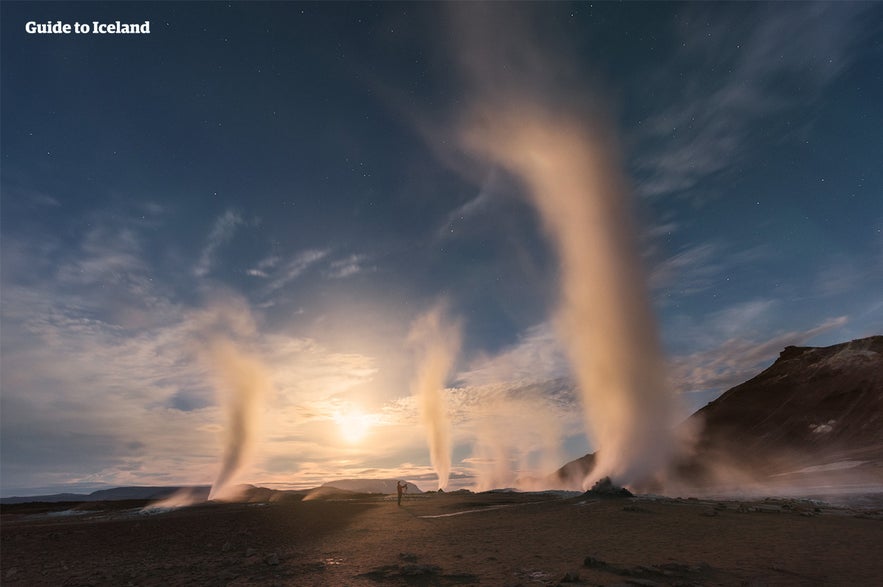 There’s plenty to see around Lake Myvatn, including geothermal hot springs, dramatic lava formations, and relaxing spas. Here are a few highlights.
There’s plenty to see around Lake Myvatn, including geothermal hot springs, dramatic lava formations, and relaxing spas. Here are a few highlights.
8. Lofthellir Cave
Just east of Lake Myvatn is Lofthellir Cave, a lava cave known for its ice formations. Its beauty comes from the striking contrast between the red lava rock ceiling and the white ice, highlighted by delicate hints of blue. The cave is about 3,500 years old and stays freezing year-round.
The entrance is narrow and requires some crawling, so it’s best suited for those comfortable with tight spaces. Guided tours, such as the Lofthellir Ice Cave tour, run from May to October, and warm clothing is essential to enjoy the experience.
7. Skutustadagigar Pseudocraters
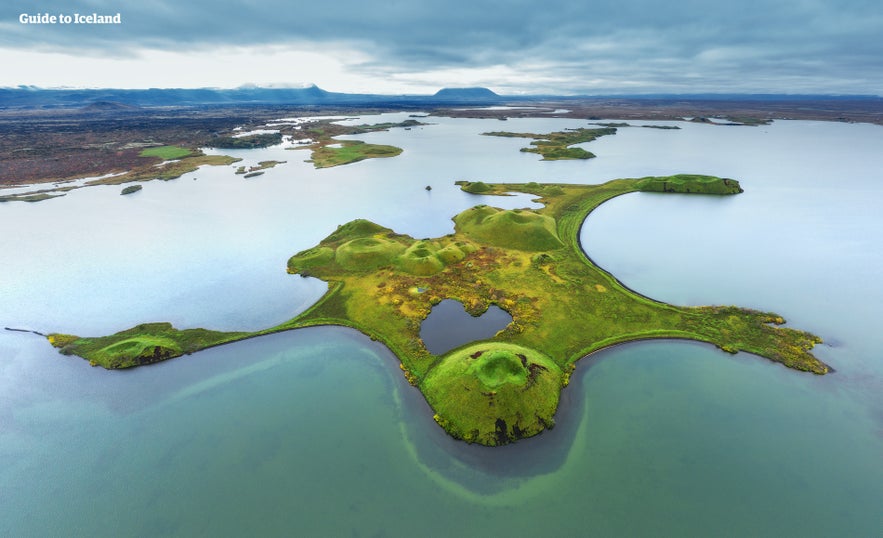
On the southern side of Lake Myvatn lies Skutustadagigar, a row of unique pseudocraters formed thousands of years ago. When hot lava flowed over wetlands, powerful steam explosions shaped the land into the crater-like formations you see today.
Skutustadagigar is part of a protected conservation area, but visitors can follow marked trails and climb some of the slopes for beautiful views of the lake. It’s also a popular spot for birdwatching, as many duck species nest in the surrounding wetlands.
6. Hverfell Crater Mountain
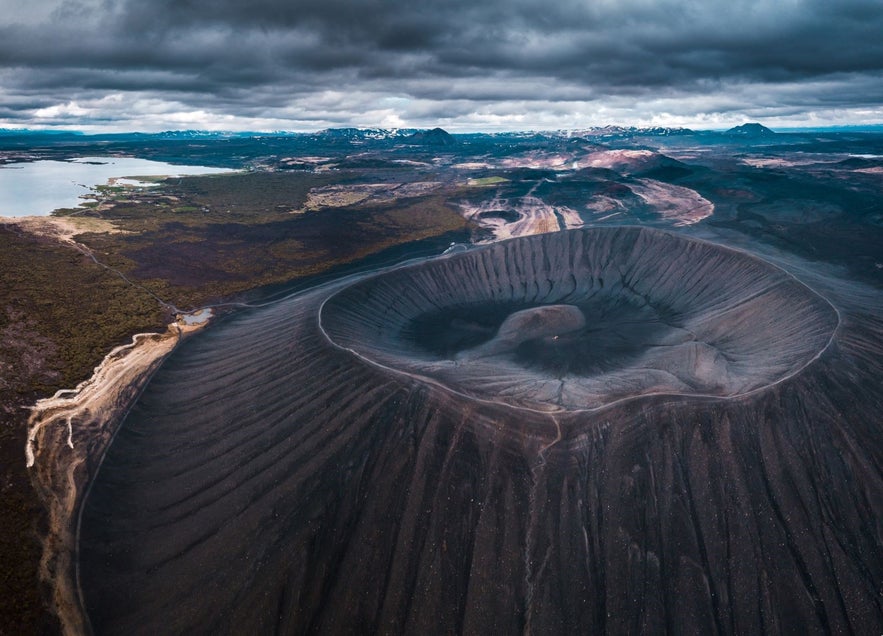
Hverfjall, also called Hverfell, is a volcanic crater and one of the most popular hiking spots near Lake Myvatn. The climb to the top is rewarding, offering sweeping views of the surrounding lava fields and landscapes.
There are two permitted trails to reach the summit. The shorter route starts near the parking area and is about 1.2 miles (2 kilometers) long. The longer route begins at the Dimmuborgir Lava Fields and forms a loop of about 5.6 to 6.2 miles (9 to 10 kilometers).
To protect the delicate volcanic terrain, stay on the marked paths at all times. At around 1,370 feet (420 meters), the crater isn’t very tall, so the hike is manageable for most visitors, including families traveling in Iceland with kids.
5. Grjotagja Hot Spring Cave
 Grjotagja is a small geothermal hot spring inside a lava cave near Dimmuborgir. Its blue water glows softly under the filtered light, giving the cave a calm, mysterious feel. The water is too hot for bathing, but the cave is still a fascinating stop when exploring the Lake Myvatn Area.
Grjotagja is a small geothermal hot spring inside a lava cave near Dimmuborgir. Its blue water glows softly under the filtered light, giving the cave a calm, mysterious feel. The water is too hot for bathing, but the cave is still a fascinating stop when exploring the Lake Myvatn Area.
Grjotagja became especially famous as one of the Game of Thrones filming locations in Iceland, where it was used for Jon Snow and Ygritte’s love scene in Season 3. In the show, a waterfall was added with CGI, so the scene looks slightly different from the real cave.
4. Viti Crater in Krafla Volcano

There are two craters in Iceland called Viti. One is in the Askja Caldera in the Highlands, while the other is near Krafla in the Lake Myvatn Region. If you’re visiting Myvatn, the Krafla Viti Crater is the one you’ll want to see.
Located just north of Namaskard Pass, the crater lies within the active Krafla Volcanic System, one of the most fascinating spots to witness volcanoes in Iceland. The area has seen 29 recorded eruptions, with the most recent, from 1975 to 1984, creating dramatic lava fields and geothermal features still visible today.
The crater itself is known for its bright aqua-blue water, which can sometimes appear green. In winter, snow often blankets the area, creating a beautiful contrast against the steaming geothermal vents and the rugged lava formations nearby.
3. Dimmuborgir Rock Formations
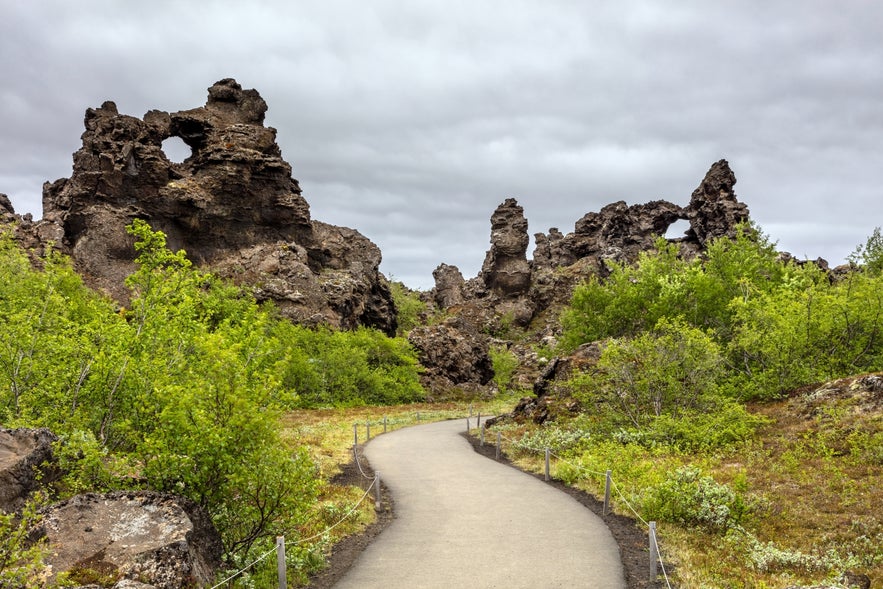
Dimmuborgir, or the Dark Fortress, is one of the most fascinating places to visit near Lake Myvatn. This lava field is filled with dramatic rock formations, caves, and towering lava columns that create a striking and unusual landscape unlike anywhere else in Iceland.
There are several hiking trails here, from short paved paths to longer gravel routes, so visitors of all abilities can enjoy exploring the area.
These unique natural formations are said to be the home of the Icelandic Yule Lads, an iconic part of Icelandic Christmas traditions. To learn more about its history and legends, you can join an 8-hour 4x4 tour of Iceland’s North Coast that includes Dimmuborgir.
2. Namaskard Geothermal Area
Namaskard Pass, on Mount Namafjall, is one of the most striking geothermal areas in Iceland. The area has bubbling mud pools, steaming vents, and bright orange and yellow clay, creating a landscape that feels almost otherworldly.
A short walking path lets you explore the area up close, but the ground is uneven and fragile, so wear sturdy shoes and stay on the marked trails. There’s no shelter from the elements, and the wind can be strong, so bring water and dress appropriately.
The mix of vivid colors, swirling steam, and geothermal activity makes this attraction one of the most unforgettable stops in North Iceland. You can visit Namaskard Pass on your own or join a sightseeing tour from Akureyri.
1. Earth Lagoon (Myvatn Nature Baths)

Hot spring bathing is one of the most popular things to do in Iceland, and the Earth Lagoon Myvatn is one of the best places to experience it, a spa previously known as the Myvatn Nature Baths.
The main lagoon has warm, mineral-rich water heated by geothermal activity, with temperatures around 97 F to 104 F (36 C to 40 C).
The complex also has steam baths powered by natural geothermal steam and a small restaurant offering snacks and drinks. In winter, it’s among the best spots to see the northern lights.
Book your admission to the Earth Lagoon and enjoy a relaxing soak surrounded by stunning natural scenery. It’s the perfect way to unwind and take in the beauty of North Iceland.
Note: Starting from January 1st, 2026, the Earth Lagoon will close for 3 months for renovations. It's expected to reopen in March/April 2026 with brand new facilities.
Best Time To Visit Lake Myvatn

The best time to visit Lake Myvatn depends on the experiences you’re looking for. Each season offers something unique, from long summer days filled with outdoor adventures to winter nights under the northern lights.
Summer brings the midnight sun, longer days for sightseeing, and vibrant green landscapes. It’s the best season for hiking in Iceland, birdwatching, and exploring attractions like Dimmuborgir and Skutustadagigar. Trails are more accessible during this time, and temperatures are milder.
Winter offers a completely different experience. The dark skies make Lake Myvatn one of the best places to see the northern lights. You can also enjoy unique activities like a 2-hour dog sledding tour with Siberian Huskies from a nearby farm.
Where To Stay Near Lake Myvatn
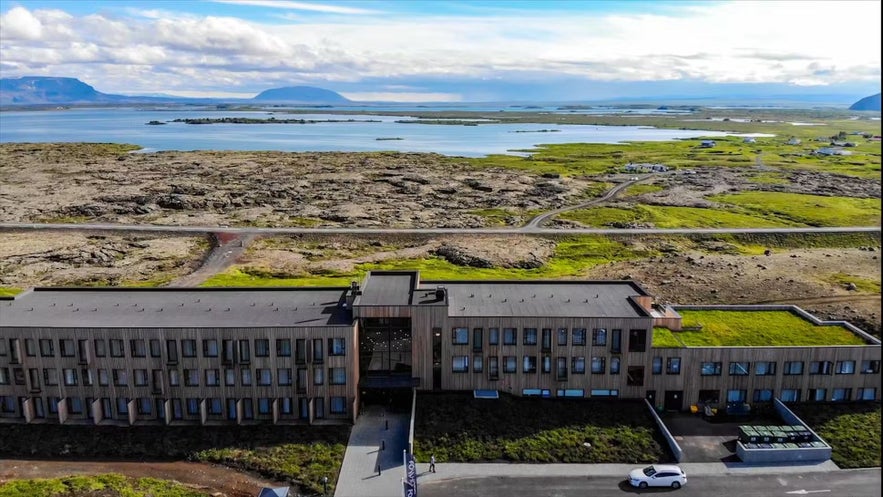
There are several excellent hotels and accommodations at Myvatn, to suit different budgets and preferences. From modern lakeside hotels to cozy guesthouses, you’ll find plenty of great options for your stay.
-
Fosshotel Myvatn: A popular choice that offers modern comfort and beautiful views of the lake. It’s also conveniently close to the Earth Lagoon, just 4.7 miles (7.5 kilometers) away.
-
Vogafjos: Another great option that’s located by the lake and known for its cozy rooms and on-site cafe serving homemade Icelandic dishes. It’s about 3.4 miles (5.5 kilometers) from the Earth Lagoon.
-
Hotel Laxa: A stylish summer hotel with comfortable rooms, excellent dining, and stunning views over the surrounding lava fields and Lake Myvatn. It’s located about 2.5 miles (4 kilometers) from Skutustadagigar Pseudocraters.
Where To Eat at Lake Myvatn
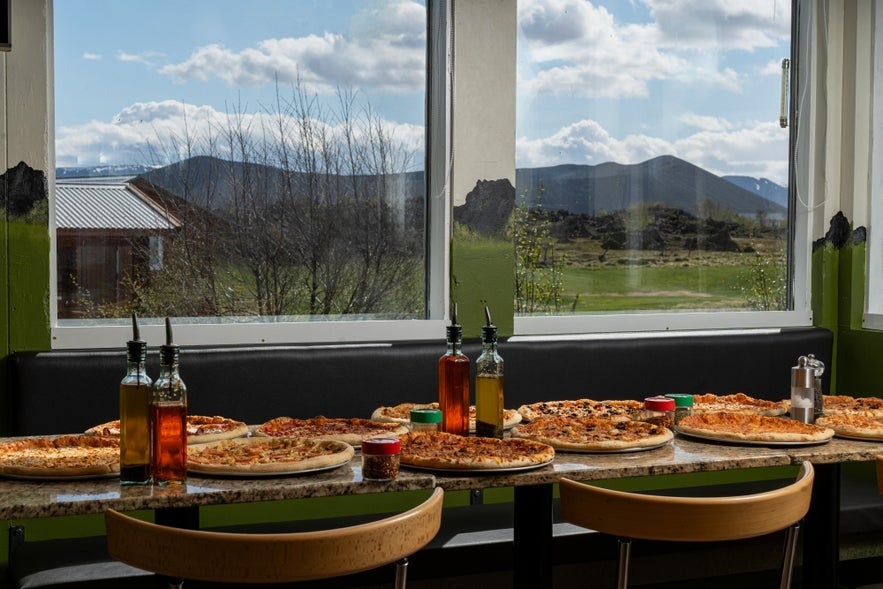 The Lake Myvatn Area offers some of the top restaurants in North Iceland, from casual spots to cozy places serving Icelandic specialties. You’ll find plenty of options, including quick bites after sightseeing and full dining experiences that showcase the region’s fresh, local flavors.
The Lake Myvatn Area offers some of the top restaurants in North Iceland, from casual spots to cozy places serving Icelandic specialties. You’ll find plenty of options, including quick bites after sightseeing and full dining experiences that showcase the region’s fresh, local flavors.
-
Daddi’s Pizza: Located near the Earth Lagoon, Daddi’s Pizza is a local favorite known for its thin, crispy crust and creative toppings like smoked trout and lamb. A new Reykjavik location opened in late 2024, offering the same popular flavors in the capital.
-
Vogafjos Cowshed Cafe: Located on the eastern shore of Lake Myvatn and just a short drive from the main attractions. Set beside a working farm, it’s known for homemade rye bread baked in geothermal heat, smoked trout, Icelandic lamb dishes, and freshly made dairy products.
-
Gamli Baerinn: It’s in the village of Reykjahlid, right by the lake, and is a convenient stop when exploring nearby attractions. It’s a great place for traditional Icelandic comfort food, serving dishes like lamb stew, fresh Arctic char, and fish of the day in a warm, rustic setting.
How To Get To Lake Myvatn
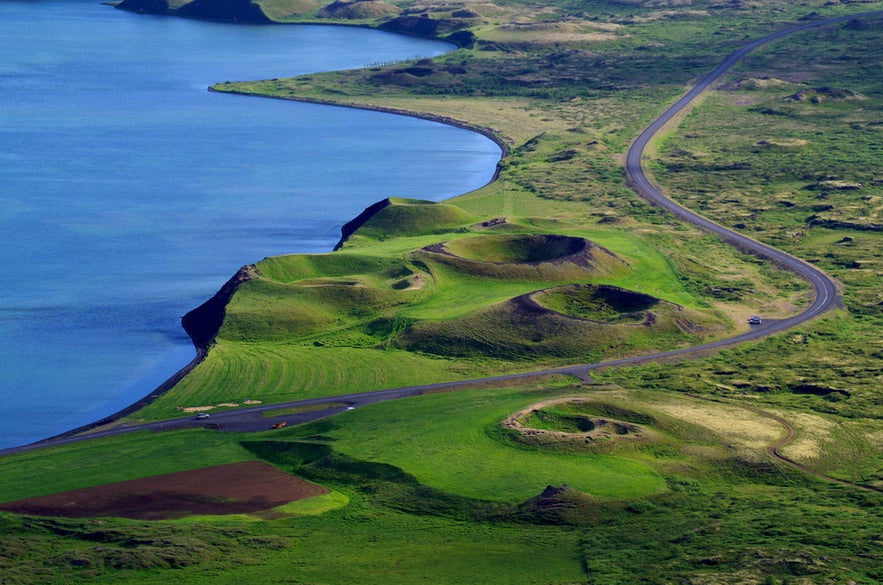 Lake Myvatn is located in North Iceland, about 286 miles (460 kilometers) from Reykjavik, with the closest main town being Akureyri. You can reach the area by car, bus, or domestic flight, depending on your travel plans and schedule.
Lake Myvatn is located in North Iceland, about 286 miles (460 kilometers) from Reykjavik, with the closest main town being Akureyri. You can reach the area by car, bus, or domestic flight, depending on your travel plans and schedule.
By Car
 Driving is the most popular and flexible way to get to Lake Myvatn. From Reykjavik, the trip takes about 6 to 7 hours via the Ring Road (Route 1), which is well-maintained and offers stunning attractions along the way.
Driving is the most popular and flexible way to get to Lake Myvatn. From Reykjavik, the trip takes about 6 to 7 hours via the Ring Road (Route 1), which is well-maintained and offers stunning attractions along the way.
Renting a car in Iceland gives you the freedom to explore nearby spots, including Dettifoss Waterfall, Dimmuborgir Lava Formations, and the Earth Lagoon.
By Flight
 You can also fly from Reykjavik Domestic Airport to Akureyri, the largest town in North Iceland. The flight takes about 45 minutes, and from Akureyri, it’s roughly a 1.5-hour drive to Lake Myvatn.
You can also fly from Reykjavik Domestic Airport to Akureyri, the largest town in North Iceland. The flight takes about 45 minutes, and from Akureyri, it’s roughly a 1.5-hour drive to Lake Myvatn.
Akureyri rental cars and guided tours are available for those who prefer not to drive in the area.
By Bus
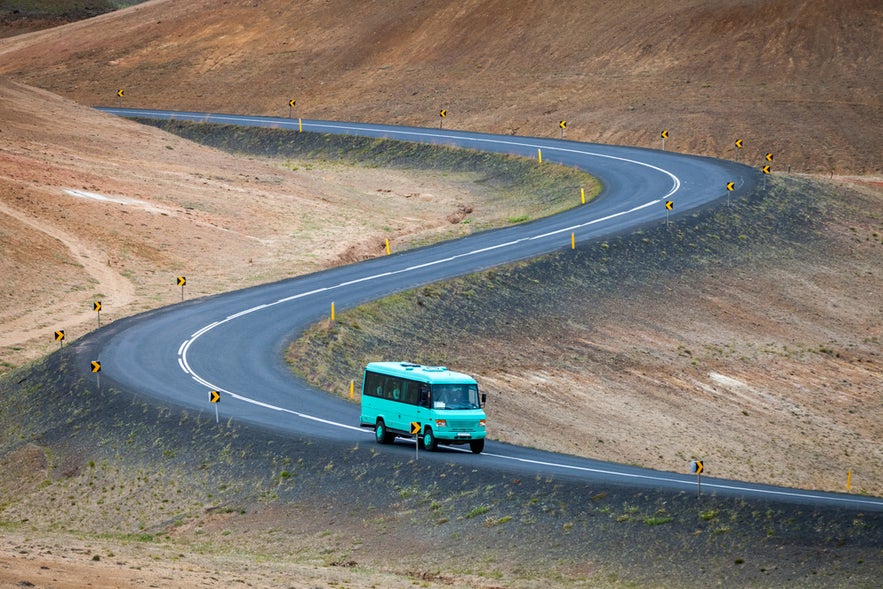 For those traveling in Iceland without a car, long-distance buses operate between Reykjavik, Akureyri, and Lake Myvatn during the summer. While this is the most budget-friendly option, schedules are limited, and travel times are longer compared to driving.
For those traveling in Iceland without a car, long-distance buses operate between Reykjavik, Akureyri, and Lake Myvatn during the summer. While this is the most budget-friendly option, schedules are limited, and travel times are longer compared to driving.
For the best experience, many travelers combine a domestic flight or bus ride to Akureyri with a rental car or guided tour to explore Lake Myvatn and its surrounding attractions. You can plan your bus trip using the route planner on the Straeto public bus website.
How To Visit Lake Myvatn Easily
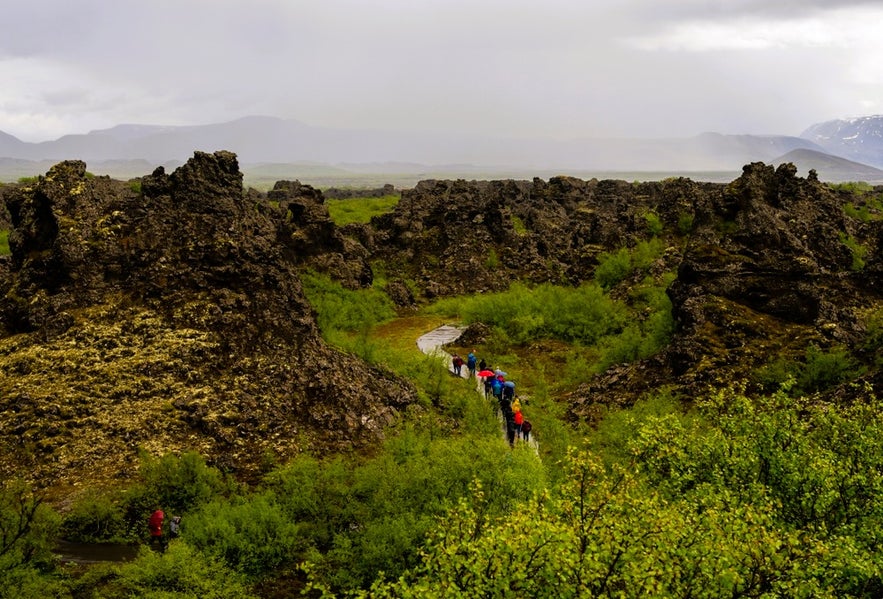 Lake Myvatn is one of North Iceland’s most stunning destinations, and there are plenty of ways to explore it. Whether you want the convenience of a guided experience, the value of an all-inclusive package, or the flexibility of a self-drive trip, these options offer the best ways to enjoy everything the area has to offer.
Lake Myvatn is one of North Iceland’s most stunning destinations, and there are plenty of ways to explore it. Whether you want the convenience of a guided experience, the value of an all-inclusive package, or the flexibility of a self-drive trip, these options offer the best ways to enjoy everything the area has to offer.
Lake Myvatn Day Tours
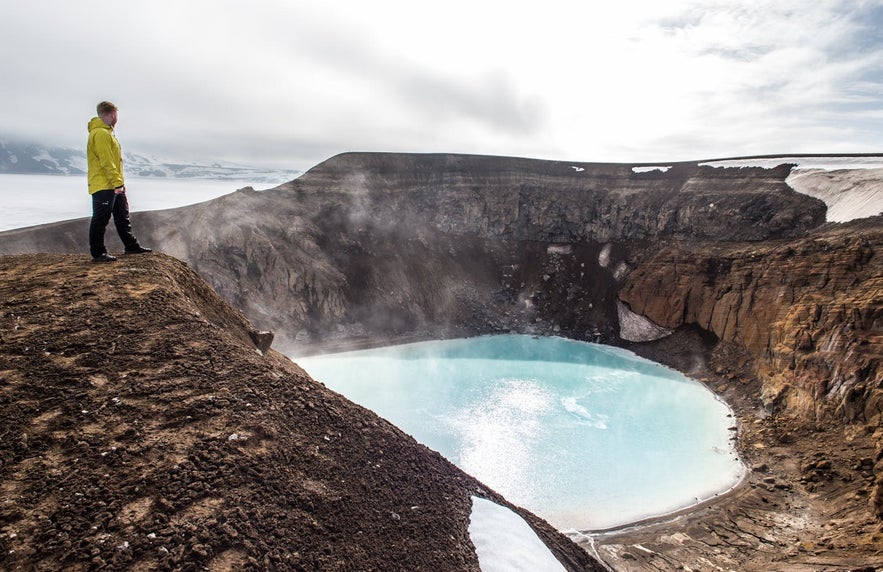
-
Lake Myvatn Bathing Tour: Visit natural hot springs and nearby geothermal areas before soaking in mineral-rich waters.
-
Lake Myvatn and Dettifoss Tour: Combine Lake Myvatn’s top attractions with Dettifoss, Europe’s most powerful waterfall, for an unforgettable day.
-
Askja Highland Super Jeep Tour: Venture into Iceland’s rugged Highlands in a Super Jeep to visit the Askja Caldera and Holuhraun Lava Field.
Lake Myvatn Multi-Day Tours
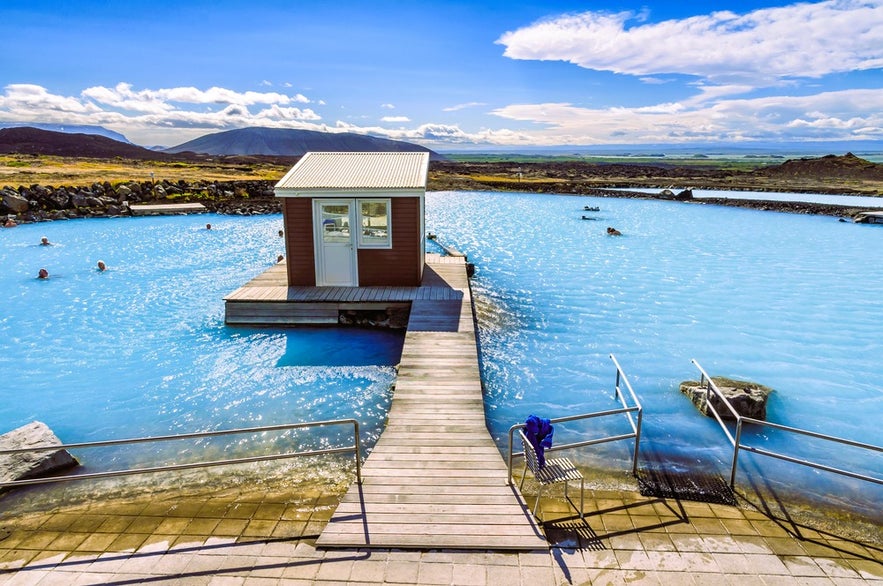
Multi-day tours are a great way to explore Lake Myvatn and its surrounding wonders at a relaxed pace. These trips include guided visits to top sights, comfortable accommodations, and extra time to enjoy the region’s unique landscapes. Here are some of the best Lake Myvatn multi-day tours for your trip:
-
8-Day Winter Ring Road Tour: A guided winter adventure featuring Lake Myvatn, the Golden Circle, South Coast, and northern lights hunting.
-
8-Day Summer Ring Road Tour: A summer adventure covering Lake Myvatn, Snaefellsnes Peninsula, waterfalls, glaciers, and the Golden Circle.
-
6-Day Circle of Iceland Guided Tour: Visit Lake Myvatn, waterfalls, glaciers, and black sand beaches with expert guides.
Lake Myvatn Vacation Packages
Vacation packages are the best choice if you want a complete Iceland experience. They combine Lake Myvatn with other top destinations and include guides, activities, and great accommodations in Iceland. Here are some of the most popular Lake Myvatn vacation packages to consider:
-
8-Day Winter Ring Road Package: A guided winter journey featuring Lake Myvatn, the Golden Circle, and Jokulsarlon Glacier Lagoon.
-
9-Day Northern Lights Package: Experience Iceland’s winter highlights, including Lake Myvatn, ice caves, glaciers, waterfalls, and aurora viewing.
-
10-Day Summer Adventure Package: Explore the full Ring Road with Lake Myvatn, national parks, black sand beaches, and extra time in Reykjavik.
Lake Myvatn Self-Drive Tours
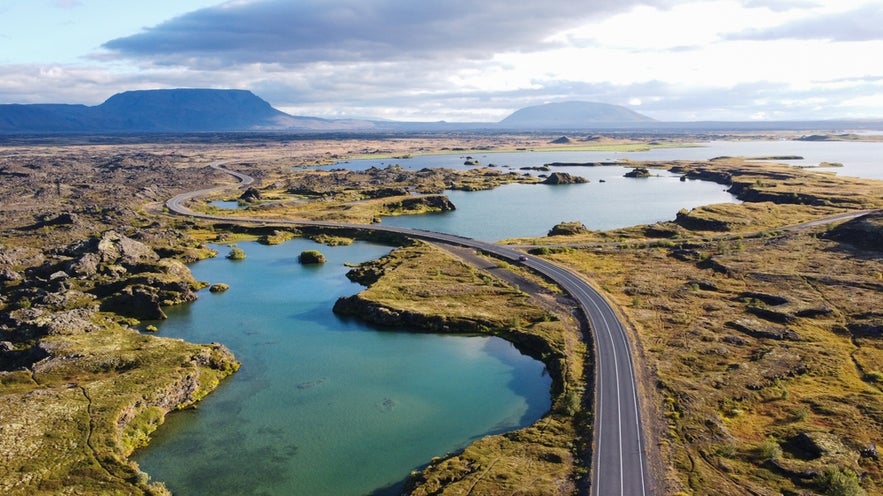
If you prefer independence, self-drive tours are the best way to explore Lake Myvatn at your own pace. They include accommodations and a planned route but leave you free to customize your trip. Here are some of the top Lake Myvatn self-drive tours to choose from:
-
8-Day Self-Drive Circle of Iceland Tour: Drive the Ring Road and visit Lake Myvatn, waterfalls, black sand beaches, and geothermal areas.
-
10-Day Iceland Self-Drive Tour: Spend more time at Lake Myvatn and enjoy a slower journey with plenty of flexibility.
-
14-Day Complete Iceland Road Trip: See the entire country, including Lake Myvatn and hidden gems off the beaten path.
FAQs About Lake Myvatn
Here are some of the most common questions about Lake Myvatn in Iceland.
Is Lake Myvatn worth visiting?
Yes, Lake Myvatn is one of Iceland’s most stunning destinations. It’s known for its geothermal activity, lava formations, rich birdlife, and natural baths, making it a great stop for both adventure and relaxation.
Can you swim in Lake Myvatn?
No, swimming in the lake isn’t recommended. The water is shallow, rocky, and has many midges in summer. Instead, relax at the Earth Lagoon, known as the “Blue Lagoon of the North”, and enjoy the warm geothermal water with beautiful views.
How deep is Lake Myvatn?
Lake Myvatn is relatively shallow, with an average depth of about 8 feet (2.5 meters) and a maximum depth of 15 feet (4.5 meters).
How much time do you need at Lake Myvatn?
Plan at least one full day to see the highlights. Staying overnight is recommended if you want to enjoy sunset, sunrise, or the northern lights in winter.
Discover the Magic of Lake Myvatn
 Lake Myvatn is one of the most beautiful places to visit in North Iceland, known for its volcanic landscapes, rich birdlife, and incredible geothermal sights. From lava fields and pseudocraters to natural hot springs, this area shows the power and beauty of Iceland’s unique scenery.
Lake Myvatn is one of the most beautiful places to visit in North Iceland, known for its volcanic landscapes, rich birdlife, and incredible geothermal sights. From lava fields and pseudocraters to natural hot springs, this area shows the power and beauty of Iceland’s unique scenery.
For more adventure, you can try dog sledding tours in winter with a team of friendly Siberian Huskies or join lava cave tours to explore hidden tunnels and geothermal chambers beneath the surface. There’s so much to see and do, making Lake Myvatn a must-visit stop on your trip to Iceland.
Which part of Lake Myvatn are you most excited about? The hot springs, lava fields, or maybe even the northern lights? Share your top picks in the comments below!

